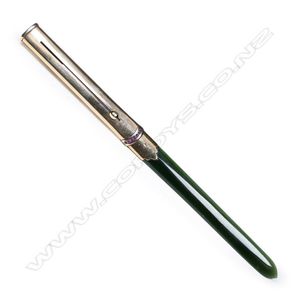Gold and Nephrite Propelling Pencil Letter Opener
Frank Hyams (Dunedin) gold and nephrite propelling pencil letter opener, the gold oval section with sliding propelling pencil and curved bands bead set with facet cut rubies. The finely tapered blade with pointed end. Length 164 mm. In fitted green Morocco leather box with maker's details in gilt to interior silk lid.
You must be a subscriber, and be logged in to view price and dealer details.
Subscribe Now to view actual auction price for this item
When you subscribe, you have the option of setting the currency in which to display prices to $Au, $US, $NZ or Stg.
This item has been sold, and the description, image and price are for reference purposes only.
- Frank Hyams Ltd. - Frank Hyams purchased a jewellery business in Princess Street Dunedin in 1885. As well as a manufacturing jeweller, he was a silversmith and goldsmith and specialised in jewellery incorporating New Zealand greenstone. At the New Zealand and South Seas Exhibition in 1890 he secured "first order of merit" for the manufacture of gold, gem and greenstone jewellery.
Concurrent with his Dunedin store, in 1902 Frank Hyams registered a limited company, Frank Hyams Ltd., and established a business in London, at 167 New Bond Street, and later at 128 New Bond Street, London, trading as 'artistic jewellers, gold and silversmiths, and dealers in gems of rarity'.
Frank Hyams established a reputation within the English aristocratic and upper class social circles for his unique one-off curiosity pieces incorporating materials and design influences from his New Zealand homeland.
The British Museum has a collection of 36 badges manufactured by Frank Hyams Ltd., circa 1906.
According to the London Gazette, in 1913 at an Extraordinary General Meeting it was voted that the company be voluntarily wound up and Frank Hyams was appointed liquidator. - Faceting - Faceting is a technique of removing material from a curved surface, to give a series of flat surfaces but retaining the profile of the original surface.
The technique is most commonly associated with diamond cutting where the various cuts used such as rose cut and brilliant cut, add life and sparkle to the stone, whilst at the same time removing as little of the stone as possible.
Faceting by grinding is also used to decorate glass. The stems of many drinking glasses are decorated by cutting a series of flat surfaces on a circular stem, and hollow vessels such as vases may have faceted surfaces.
In furniture faceting is often applied to legs of tables and chairs, where a circular baluster shaped section is flattened so as to form an octagonal section.
This item has been included into following indexes:
